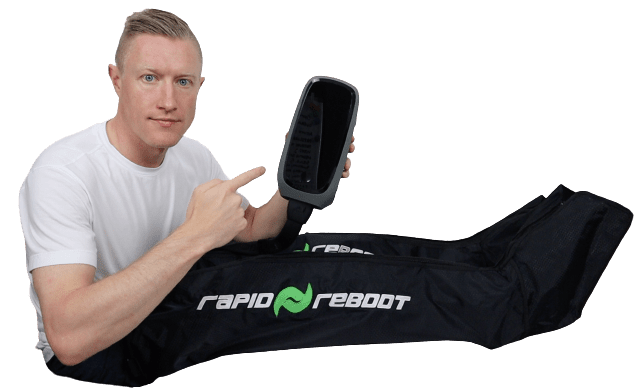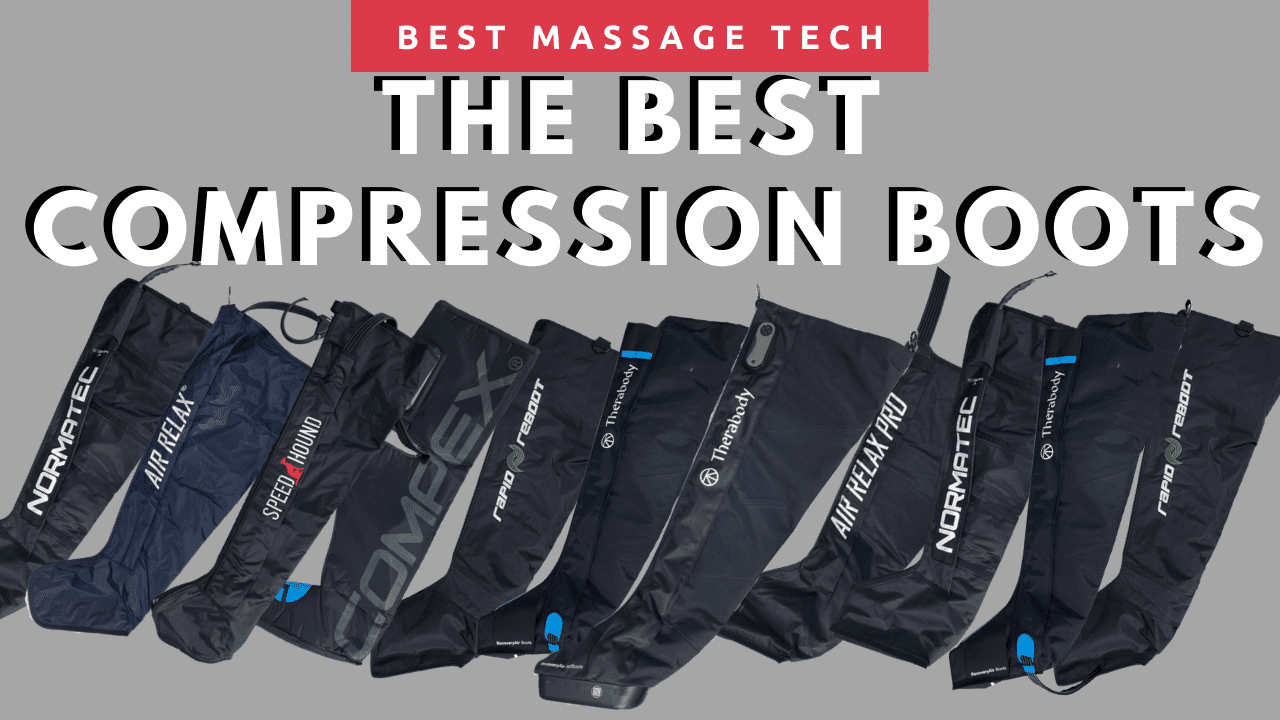
So you’ve heard about one of the newest trends in the athlete recovery space – pneumatic compression recovery boots – and you’ve decided you’d like to purchase a set. However, you don’t know what you should be looking for and you aren’t sure what makes one set better than another. There are a lot of different factors to consider and a lot of different features each set of boots incorporates depending on the price point. Speaking of price point, what’s the difference between a $500 pair and a $1,500 pair!? Best Massage Tech has tried and reviewed almost every compression recovery boot brand (check out our spreadsheet that proves it!) and have come up with a list of what we think every person should consider prior to making an investment into a pair of these recovery devices.
15 Things To Consider When Buying Compression Recovery Boots
Number of Zones or Chambers
Zones or chambers are the sections of the attachment that fills with air within the fabric of the boot. This is one of the easiest features to determine when evaluating a pair of boots because it is a visible feature on many brands. The number of zones or chambers the device has correlates to how smoothly the attachment will fill and how effective it will be in moving the fluid in your body. Typically the more chambers, the more control it gives you in your recovery routine. The standard we’ve established for this category is a minimum of 4 chambers.
Do The Zones or Chambers Overlap
The purpose of compression boots, is to move fluid, such as blood or lymphatic fluid, toward your core. An important factor of moving fluid is ensuring there is a constant pressure behind the fluid. So, when it comes to the zones and how effective they are at moving your fluid, it’s important to determine whether they overlap. Zones that do not overlap, allow for “error” between chambers and your fluids have the opportunity to back flow. Whereas overlapping chambers, allow for a smooth transition of pressure to flow from the furthest end of of your body to the closest part of your body. An analogy we like for overlapping chambers is to think about them as squeezing a tube of toothpaste – as long as all the pressure moves in one direction, so does the toothpaste.
Can You Activate and Deactivate Individual Zones or Chambers
Having the ability to turn individual zones and chambers off is a nice added benefit to any pair of compression boots. This feature is primarily designed from a medical perspective as it is often used when treating injuries post surgery or any injuries that may involve swelling of a particular area of your leg such as an ankle or knee. It’s not necessarily the most important feature, but the devices that are able to accommodate this function have a ‘leg up’ in our book! Another added benefit of being able to deactivate an individual zone is that it may provide a better fit for your boots. If your boots are slightly too long, deactivating the top chamber of your leg would allow you to achieve a better fit and allow you to either pull the boots up a bit more or unzip the top chamber and fold it back slightly.
Number of Pressure Settings
The number of pressure settings a pair of compression boots has is important when it comes to how comfortable you are able to make your user experience. The more settings a pair of boots has, the more specific you are able to set the pressure in each zone. Most boots have settings that can range from 1mmHg up to 20mmHg of difference between settings. For any pair of boots that adjusts in increments of 20mmHg, it could be difficult to find the best comfort level because the range is so wide – you may only want to make it a little less or a little more, but you don’t have that option. The devices that allow you to focus your pressure down to 1mmHg settings are great as they allow you to really narrow in on what is comfortable for you. Customization is key!
Pressure Range
The overall pressure range relates to how low the pressure can be in any zone and how high it can be in any zone. In order for your body to effectively move fluid, the pressure has to at least exceed your diastolic blood pressure – or the pressure against your artery walls between heart beats. It does not necessarily need to excessively exceed your diastolic blood pressure, but some devices have pressure ranges that go very high in order to mimic a massage. A device that goes well below your blood pressure, can be beneficial when dealing with injuries or medical conditions that do not allow a comfortable use at a higher pressure. The varying levels of pressure can be utilized to create a compression massage. Most systems have a maximum pressure between 100-220mmHg.
Number of Modes or Patterns
Every user experience is going to be different when using compression recovery boots. That is why the number of modes or patterns a device has is important to consider for your user experience. While one user may want a chamber to fill and hold until all chambers are filled, another user could prefer chambers to inflate and deflate one at a time. The more recovery modes a pair of boots has, the higher likelihood you will be able to find a routine that best suits you. Bonus points for the handful of devices that allow you to create and save custom routines based on your specific preferences. Most devices that have Bluetooth compatibility allow for this bonus feature.
Negative Compression Gradient
Negative compression gradient means that the pressure is always higher in the further chamber than the next closest chamber to your body (pressure is higher distally than proximally). A negative compression gradient ensures that the fluid in your body has no opportunity to back flow and will always move toward your core. Refer to our toothpaste analogy above! Devices without a negative compression gradient are likely not moving as much of your fluids, and therefore are not as effective, as devices that do have this standard (or have the ability to create it manually through custom modes).
Sizing
If you are going to spend the money on compression recovery boots, you’re going to want them to fit. Fit not only has to do with the length, but also the circumference. Those with larger thighs will need to ensure their legs will fit within the boots. Most boots offer a variety of sizes, the but the more size options they offer the better as this will ensure the best chance of them fitting. If you have legs with a larger circumference, some brands (but not all) have an additional zippered insert for a larger leg, and some have more than one zipper on the boots themselves. Remember, boots that allow you to deactivate zones may allow you to fit into a bigger boot by deactivating the top zone.
Bluetooth Compatibility
The future of recovery tech is on your smart phone. The devices that have their own app and have Bluetooth compatibility with their devices are forward thinkings and care about the user experience. Having Bluetooth functionality allows your boots to connect with an app for custom controls. Every brand that has an app allows for more functionality in their app than on the unit by itself. There’s also the added benefit with being able to integrate with forward thinking features, such as possibly allowing Alexa or Google Home to control and adjust pressure settings through audio commands. Any brand that has Bluetooth compatibility is invested in making your experience the best possible and should be recognized for that.
Battery Life
First you need to consider if your device is battery powered or not. A battery powered device is going to allow you the flexibility to take your compression recovery boots with you wherever you’d like. Whereas, a non-battery powered device, limits you to as far as the cord will reach.
For the battery powered devices, you’ll want the battery to last for a significant amount of time – which we consider to be at least 2 hours, or enough to allow you to get several usage sessions before needing to be recharged. Some battery powered compression boots will last up to 8 hours depending on how frequently and what pressure setting they are being used at.
Session Usage Time
The amount of time you can use the device in a single compression session is important. Being able to wear them for an hour without having to adjust anything should be the standard that is considered. While there are some boots that only allow 15-30 minutes per session are fine, getting up to restart your device is certainly not something you are going to want to do one you’re laid back and relaxed. If you want to really feel recovered, some devices have continuous mode and allow for non-stop use and some have up to 8 hour session times with 30-60 minute breaks between fill cycles – this is typically for use in the medical space post-surgery.
Case
Every investment in your body deserves to be protected, so if your device doesn’t come with a case, then you need to consider setting aside an additional budget that you will need to spend to purchase a case or a way to transport them. A surprising amount of devices do not include a case and that’s disappointing.
Price
Arguably the most important factor to consider. Determining what your budget is and what value and features you will get for your investment needs to be considered. There are devices out there ranging from as low as $500 all the way up to $1,500 or more.
Warranty
If you’re going to spend hundreds of dollars, the product should guarantee itself for at least one year. The longer the warranty the better. Be sure to pay attention to any details regarding different warranties between the pump unit and the device itself. Many brands offer a 30 or 60 day trial period. Therabody for example, offers a 60 day period on RecoveryAir products.
Additional Factors to Consider
Noise
Not that any of these devices are extremely loud, but nobody wants to be distracted by the sound of a motor and pump when they are trying to relax after a tough workout.
Number of Compatible Attachments
Does the company only make boots? Or do they also have additional attachments such as hips, arms, core, etc. The more attachments the device has, the more versatile your recovery can become.
Unique Features
Is there anything the brand you are considering has that others do not? This could be a special setting, a special sizing attachment, or something like the Rapid Deflate on the newest Rapid Reboot compression recovery products.
Discounts
Are there any discounts available to help you find your compression recovery boots for a cheaper price than what they are being advertised for? Best Massage Tech has a lot of great opportunities to save you some money on your investment. You can access our list of available discounts as well as our full comparison spreadsheet between almost every compression recovery boot brand HERE. When in doubt, shoot us an email (BestMassageTechnology@gmail.com) as not all of our discounts are advertised.

